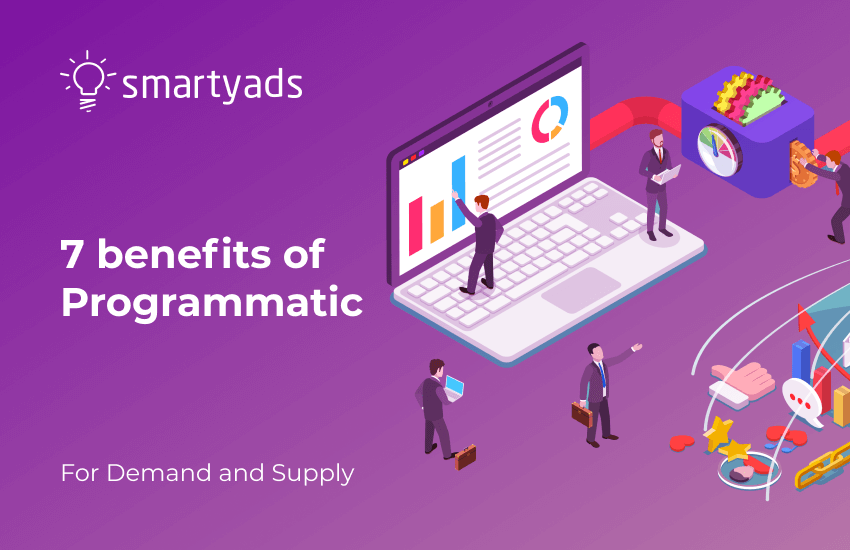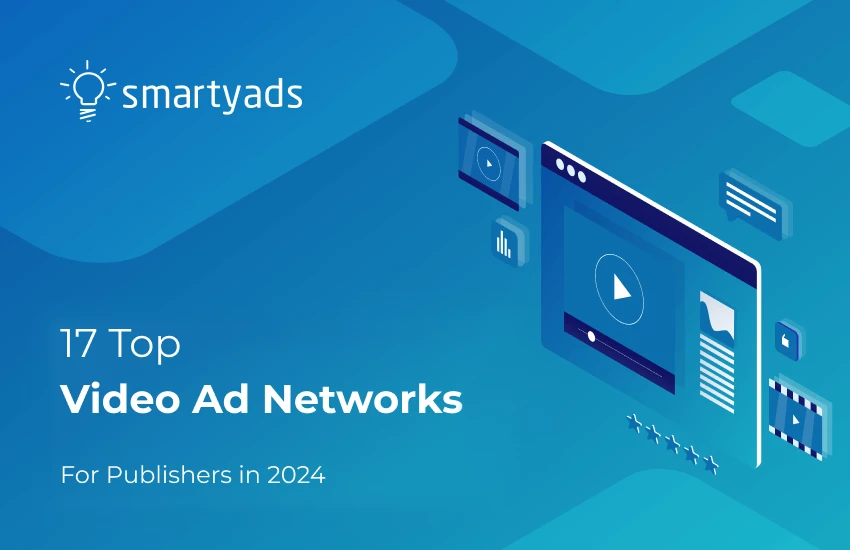Programmatic digital ad spend in the world will reach $725 billion by 2026. Programmatic advertising, explained as programmatic ad buying, has demonstrated steady growth ever since it became possible to place ads automatically.
The benefits of programmatic advertising are obvious to demand and supply partners; that's why programmatic campaigns account for roughly 70% of total display campaigns.
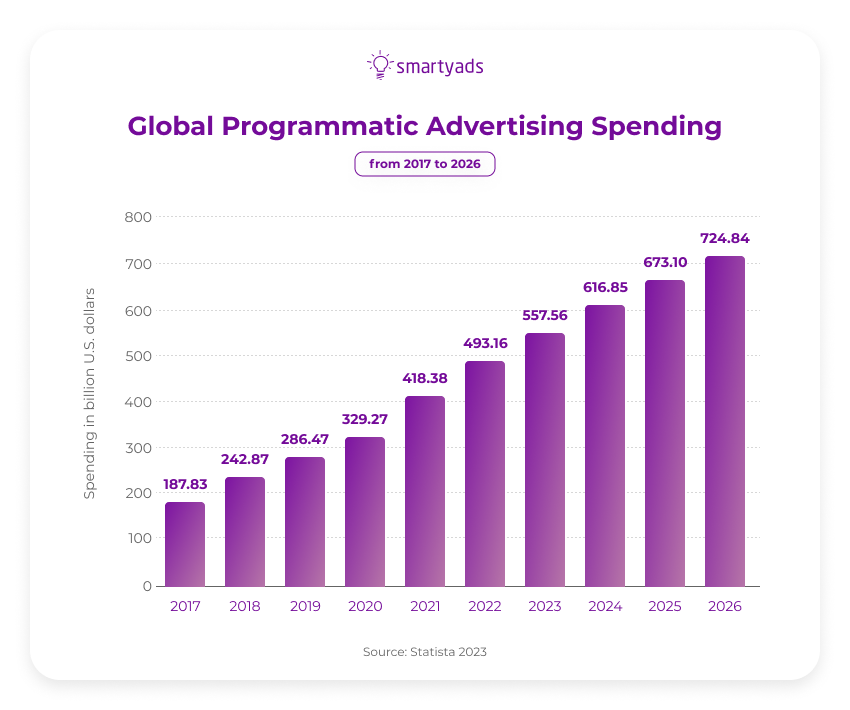
As more data becomes available, data-driven algorithms improve, the targeting capabilities evolve, real-time optimization and other factors come into play, programmatic advertising becomes more effective and worth investing in.
Let's discover the benefits of programmatic advertising. Then, let's get practical and see how a programmatic advertising platform can be useful (supply-side platform for publishers and demand-side platform for advertisers and marketers).
Programmatic advertising advantages for 2024:
- Programmatic advertising turns multichannel into omnichannel;
- Programmatic advertising is individual;
- Increased audience reach;
- Data advantages of programmatic advertising;
- Flexible deal types in programmatic advertising;
- Safer advertising ecosystem for everyone;
- Best reporting.
1. Programmatic advertising turns multichannel into omnichannel
The benefits of programmatic advertising are endless, but the omnichannel approach is what really makes this technology unique.
The proliferation of customer touchpoints has seen a dramatic rise, necessitating advertisers to engage with customers across these diverse platforms.
Through programmatic approaches, advertisers and marketers gain the capability to connect with customers seamlessly on a variety of devices, including smartphones, tablets, desktops, and even television screens, all concurrently.
The process of programmatic advertising automation facilitates the synchronization of campaigns across multiple devices, ensuring precise ad delivery to the intended audiences. This automated algorithm also extends its benefits to publishers, granting them enhanced control over inventory management. Publishers can opt to engage in open auctions or leverage private marketplaces to sell premium inventory through preferred deals or programmatic guaranteed arrangements.
Example of an omnichannel approach
Programmatic ads can bring you an additional share of customers. For example, the digital marketing team of Starbucks launched a user loyalty program based on personal user cards.
Such cards were linked to personal accounts that the user accessed via smartphone. If coffee was ordered via smartphone, the app calculated the time the user would take to get to Starbucks. By the time of arrival, the coffee was already waiting for the customer.
With programmatic advertising, such ads could be delivered to the right audience at the right time and across many channels — mobile, CTV devices, desktop, and more.
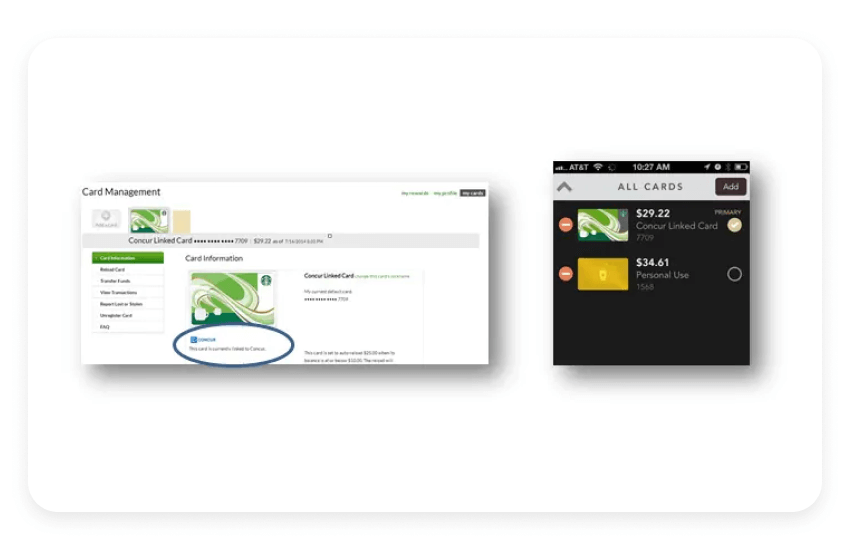
2. Programmatic advertising is individual
Programmatic advertising provides accurate audience targeting and instant ad delivery through real-time bidding.
Programmatic advertising operates through the utilization of data-driven insights concerning prospective customers, also known as target audiences. In straightforward terms, the orchestration involves AI and ML algorithms strategically presenting a particular ad unit to an individual user precisely when it's expected to garner optimal visibility.
This communication reaches its intended audience by incorporating the targeting specifications and trading guidelines established by advertisers and marketers within the programmatic platform. These platforms encompass DSPs (demand-side platforms), ad exchanges, or ad networks.
For instance, consider a scenario where a brand harnesses programmatic capabilities to engage with specific consumer segments. This strategic interaction involves targeting parameters such as devices used, geographical location, personal interests, and content preferences.
Example of real-time advertising individualization
Every time the user opens a publisher's app or a website, the bid request, along with user information, is sent to an ad exchange.
It's like saying, "Hey, user X is 35 years old; lives in Montana; uses iOS; is interested in cars, football, and traveling; possibly married; and most likely self-employed. He is about to see an ad. Who wants to advertise to him?"
Judging by the user's characteristics, advertisers' demand-side platforms determine whether this view-through is valuable to the advertisers.
If yes, they bid on it. A display ad is served. Publishers earn money from showing programmatic ads to niche audiences, while brands get the chance to reach prospects with relevant ads anytime and anywhere. Here's an example of how it all works:
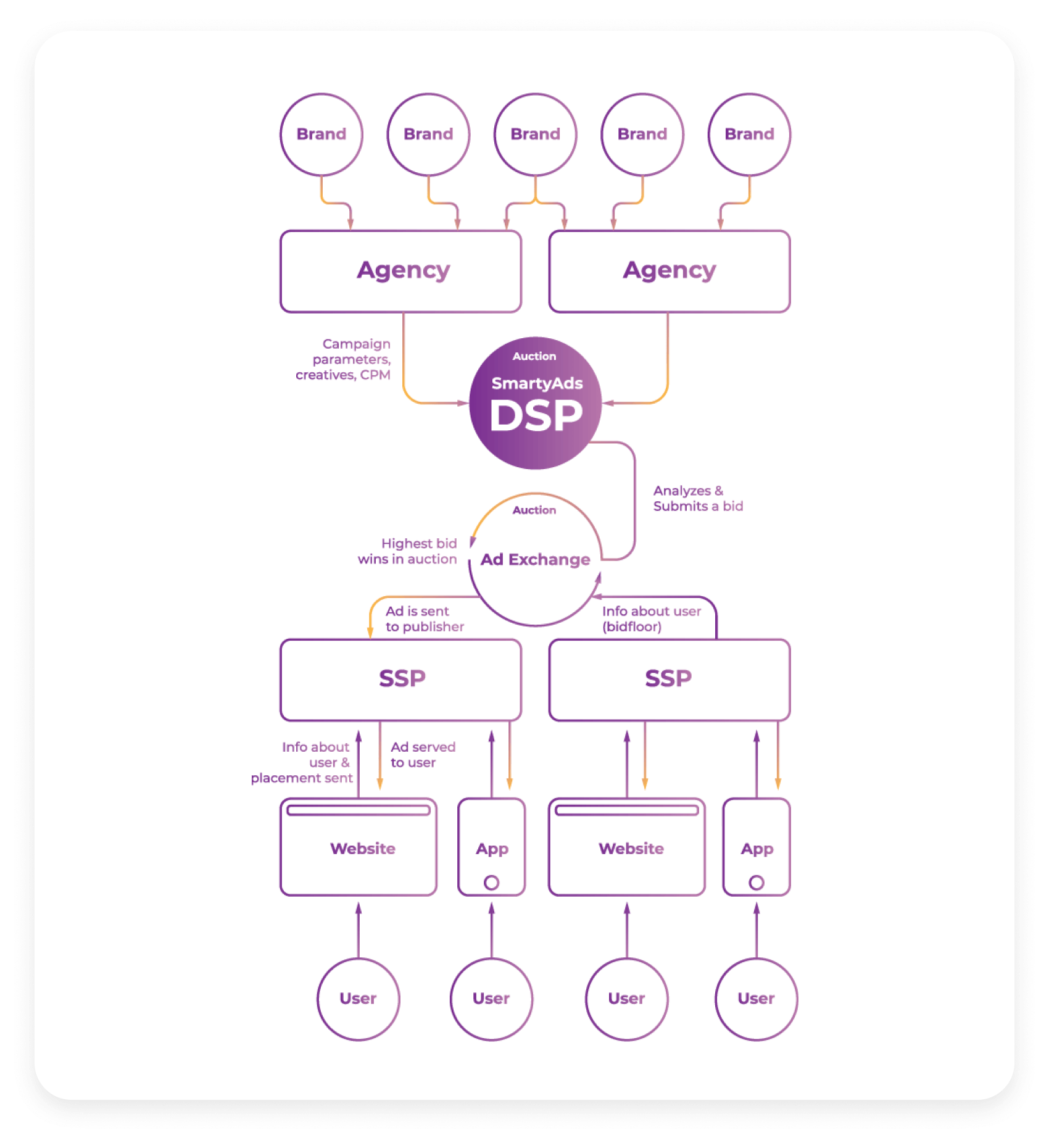
3. Increased audience reach
One of the key benefits of programmatic advertising is the ability to automatically reach the user segments that are most likely to convert.
Advantages also include look-alike modeling that makes user acquisition reasonably cheap.
This means that AI and ML algorithms have earlier defined that certain user segments have a good history of clicks on this or that type of digital ad space. Here's an example of how DSP works:
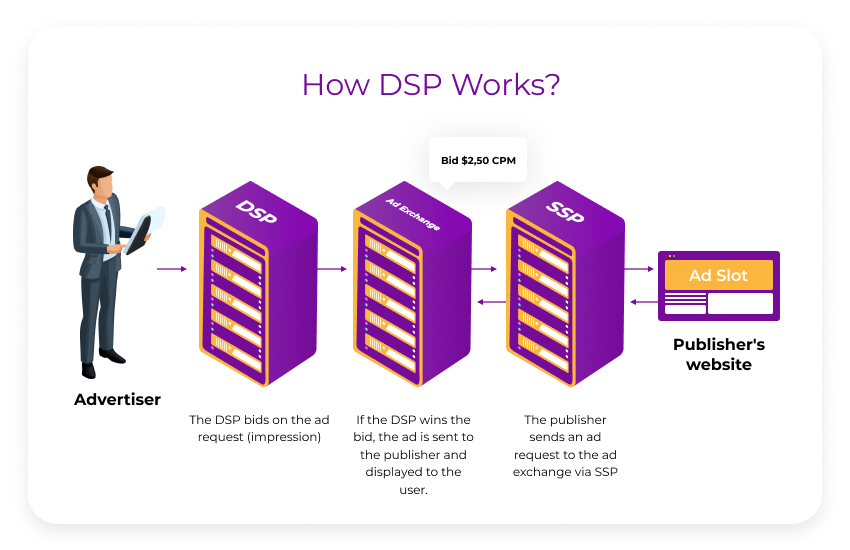
An example of increased reach
A clothing brand that manufactures sportswear for snowboarders found out that their sports accessories, especially sunglasses, are regularly bought by a completely new target audience — cyclers, hikers, and teenagers who know that sports glasses turned into a fashion trend.
This way, programmatic advertising offers the product in a new category — fashion.
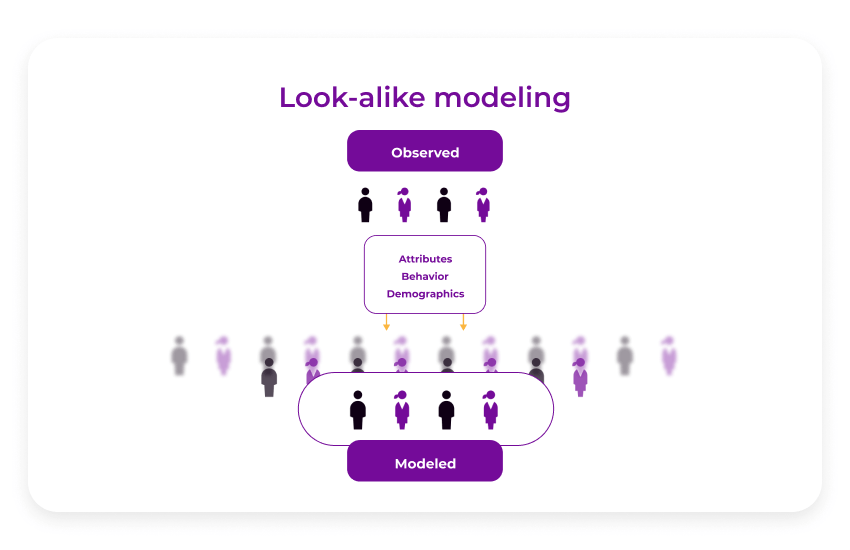
4. Data advantages of programmatic advertising
Programmatic advertising work is based on data. For instance, data management platforms collect first- and third-party data on existing consumers from different channels, devices, and offline and online sources.
The platform can gather and analyze user segments in real time and then serve ads based on this data.
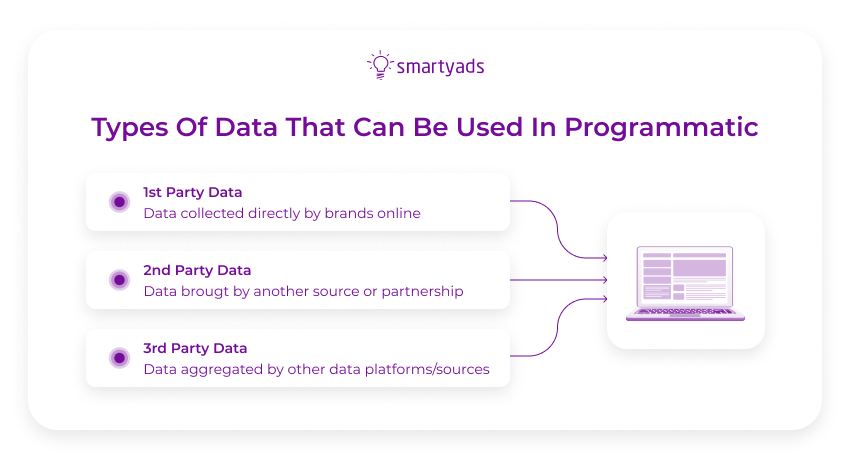
The entire programmatic ad-buying process is based on the information — behavioral factors, personal preferences, and tastes of the potential customer.
Analytics is also one of the benefits of programmatic advertising. It is used to analyze the media trading on a day-to-day basis to reveal patterns and get actionable insights about impressions, ad dollars spent, win rates, video completion, and so on.
Example of benefits in campaign analysis
Conventional advertising methods lack the precision measurement offered by programmatic advertising, particularly in the context of Connected TV (CTV).
Programmatic offers advertisers a streamlined solution accompanied by numerous advantages, such as the real-time generation of campaign reports.
Furthermore, advertisers and marketers can make adaptations guided by data from programmatic ad campaigns.
With a comprehensive dataset readily available, advertisers can also initiate geo-targeting campaigns with exceptional precision, ensuring that ads reach individuals in close proximity to their brick-and-mortar store.
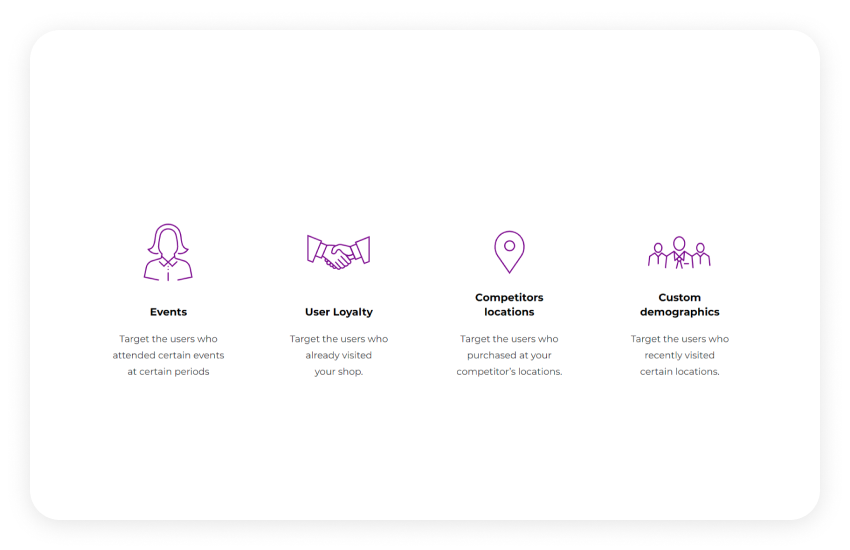
5. Flexible deal types in programmatic advertising
Another benefit is that programmatic advertising provides immediate access to the pool of digital inventory, excluding the chance of human error. There are several deal types in programmatic, each with particular perks.
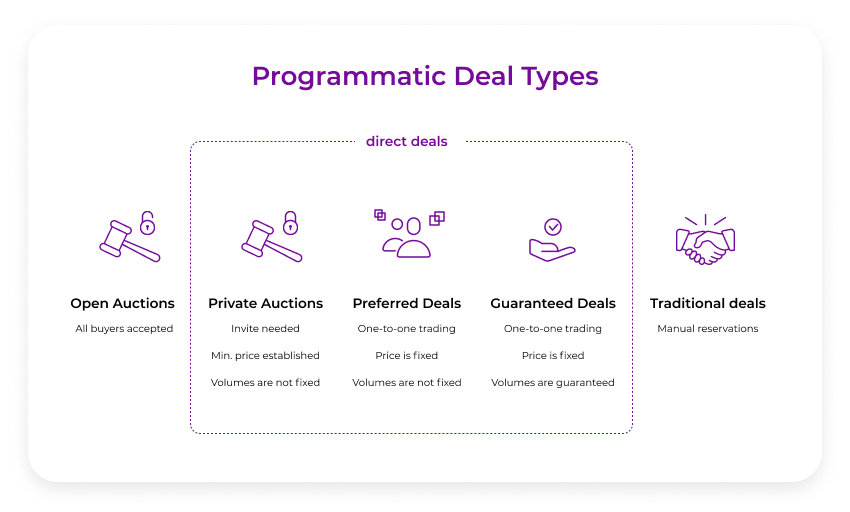
Programmatic advertising means ample opportunities for advertisers to start buying digital media inventory from a myriad of publishers worldwide.
The publisher can sell both premium inventories (private marketplace) and remnants (RTB auction) — this all becomes available through platforms like SSP.
Meanwhile, publishers enjoy the benefits of the increased demand during programmatic buying, which allows them to sell impressions at competitive prices and successfully monetize their traffic.
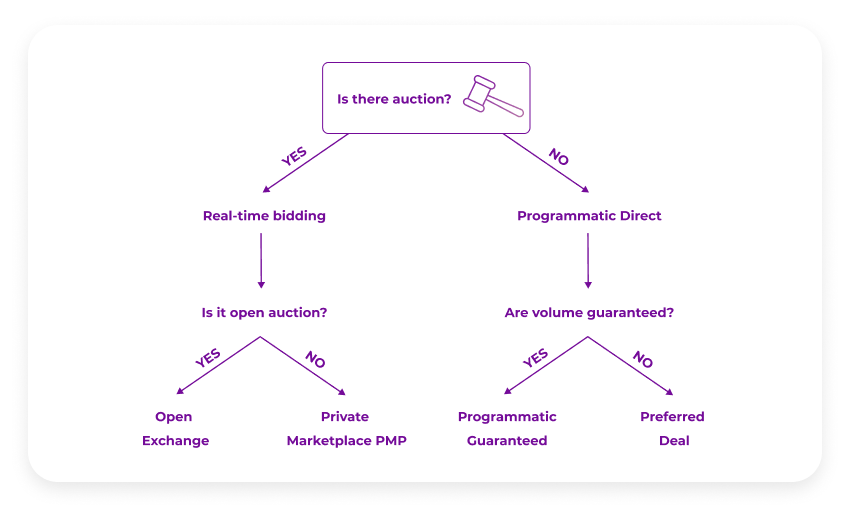
Example of how ad space can be bought and sold
Marketers are purchasing ad space on a per-impression basis through real-time bidding auctions, or they may opt for programmatic direct deals and buy guaranteed ad impressions from specific publishers.
Alternatively, there are private marketplaces (PMPs) where premium publishers offer exclusive niche audiences to members on an invitation-only basis. Finally, there are preferred deals that are fixed price agreements between publishers and advertisers.
6. Safer advertising ecosystem for everyone
Ad fraud affects all digital marketing, creating malicious traffic. As a result, the ads are seen not by people but by bots that never convert into customers, so the ad budget is typically wasted.
Brand safety risks also appear when the ad is served near inappropriate content. Another issue with transparency is related to inflated prices and commissions inside the chain during the process of media trading.
Today programmatic advertising solutions should be characterized by increased transparency during trading and the chance to secure the ad budget from fraudsters.
How programmatic advertising makes campaigns safer
One of the critical safety solutions that appeared last year was ads.txt. It authorizes individual media sellers who are eligible to sell the inventory.
Also, in 2019, IAB Tech released ads.cert, which is responsible for delivering clear and detailed information about ad space.
The big step towards transparency and safety of programmatic advertising is the adoption of the first blockchain-based ad platforms, which are safe, secure, and incorruptible by design.
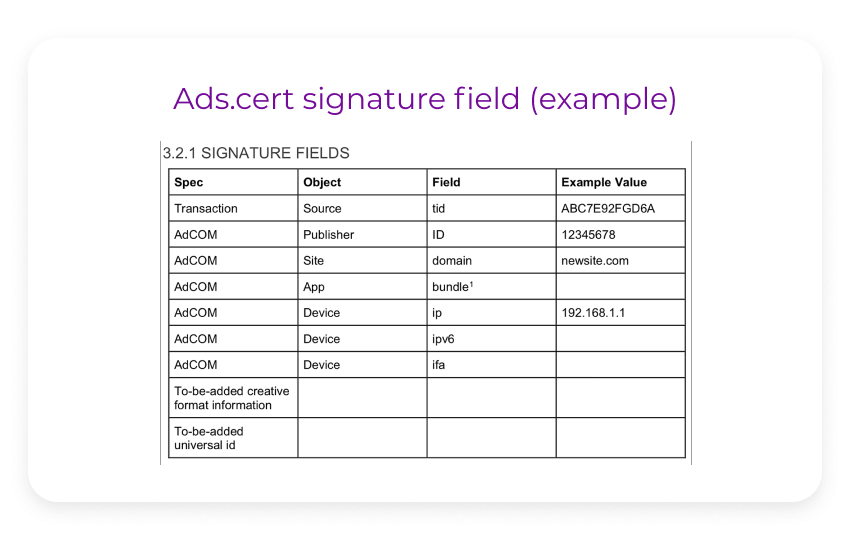
7. Best reporting
Another benefit of programmatic buying is that it provides robust reporting and granular analytics of campaigns, budgets, and the media trading process in real time.
Programmatic advertising platforms offer a variety of analytic tools to provide users with insights into the automated process — what is going on, how campaigns perform, and how the budget is getting spent. No need to calculate everything manually; machines handle all calculations.
How campaigns can be analyzed
Media buyers can access reports through dashboards and track ad performance according to key marketing metrics such as click-through rate (CTR), traffic, conversion rate, bounce rate, consumer engagement rate, brand awareness, and overall ROI.
Afterword
In the current surge of digital advertising's effectiveness, integrating programmatic into your comprehensive marketing strategy has become imperative. The advantages of programmatic media buying revolve around delivering personalized messages, departing from the conventional approach of mass ad campaigns.
By adopting this approach, your advertising endeavors remain tailored and targeted, thereby minimizing the occurrence of wasted impressions. The programmatic mechanism operates akin to an adaptive autopilot for your advertising efforts, consistently steering the programmatic ad campaign workflow in accordance with pre-established data inputs.
Essential knowledge basics in this area today are enough to master the art of professional digital advertising that's efficient, timely, and up to a point.
Create the best programmatic advertising campaigns with SmartyAds DSP!
FAQ
The programmatic methodology provides pinpoint accuracy in targeting, immediate optimization, and streamlined ad purchasing. It elevates ROI by engaging the correct audience with pertinent content. Automation simplifies processes, conserving time and minimizing human errors. Data-fueled insights elevate campaign efficacy, and the capacity for scalability facilitates broader audience engagement. On the whole, programmatic advertising heightens efficiency and effectiveness in digital marketing endeavors.
Yes, programmatic advertising is highly effective. Its data-driven approach and real-time optimization enable precise targeting and efficient allocation of ad budgets. This leads to improved ROI and campaign performance. However, success depends on strategy, data quality, and ongoing optimization. When executed well, digital advertising can deliver impressive results in reaching and engaging the right audience.
Programmatic advertising is better due to its data-driven precision, real-time optimization, and efficient automation. It reaches the right audience with personalized messages, improving engagement and conversion rates. Automation reduces manual effort and minimizes errors, enhancing campaign efficiency. Its ability to adapt quickly to changing market conditions and audience behavior makes programmatic advertising superior for effective and impactful digital marketing.
